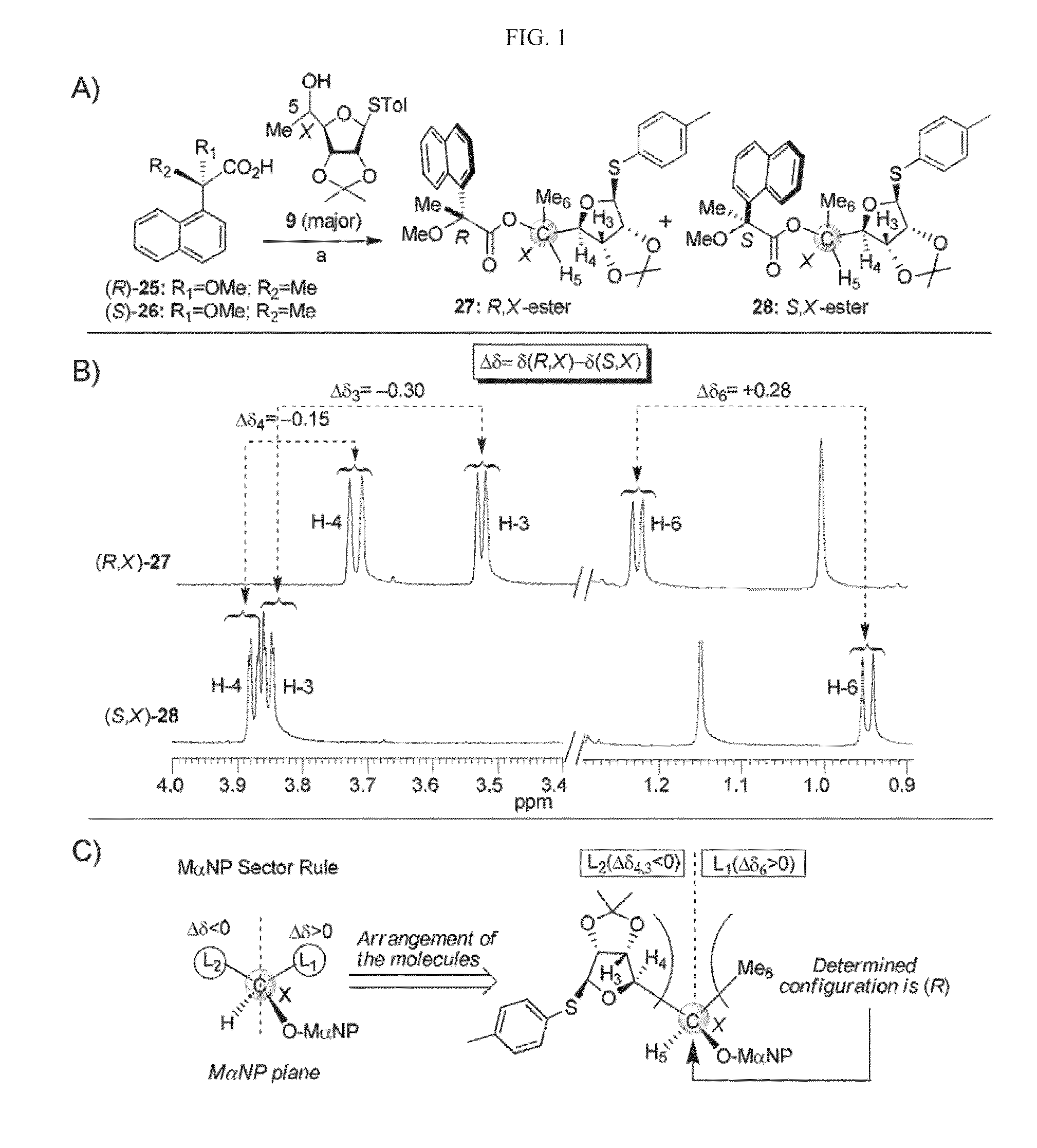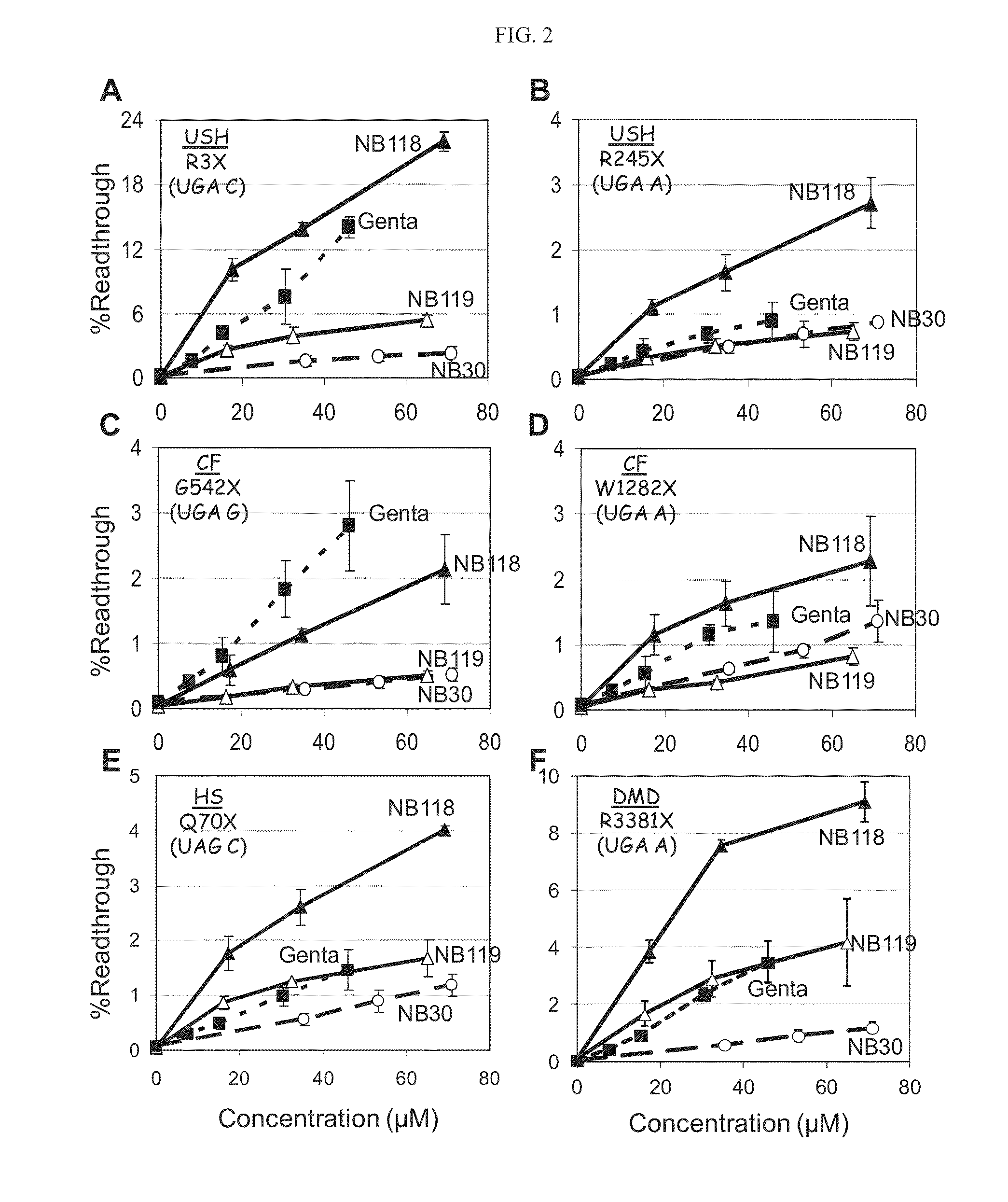Aminoglycosides and uses thereof in treating genetic disorders
a technology of aminoglycosides and genetic disorders, applied in the field of aminoglycosides, can solve the problems of many critical problems to be solved, premature termination of translation and eventually truncation of inactive proteins, and undesirable antimicrobial activity of read-through drugs, and achieves low toxicity, high premature stop-codon mutation read-through activity, and the effect of being beneficially used
- Summary
- Abstract
- Description
- Claims
- Application Information
AI Technical Summary
Benefits of technology
Problems solved by technology
Method used
Image
Examples
example 1
[0259]Synthetic Procedures:
[0260]Compounds NB118, NB119, NB122, NB123, NB124, NB125, NB127 and NB128 were synthesized according to a general procedure that involves construction of Ring III as two individual compounds possessing (S)-5-methyl and (R)-5-methyl with already established stereochemistry (Compound (S)-17 and Compound (R)-18), and using them as donors for the glycosylation reactions. These donors were readily accessible from the known thioglycoside Compound 7 as illustrated in Scheme 2 below (wherein “a” represents 1,1-dimethoxypropane, CSA, acetone, room temperature; “b” represents Dess-Martin periodinane (DMP), DCM, room temperature; “c” represents MeMgBr, THF, −30° C.; “d” represents TsCl, Py, 4-DMAP, room temperature; “e” represents NaN3, HMPA, DMF, 70° C.; “f” represents acetic acid / water (8:2), reflux; “g” represents BzCl, Py, 4-DMAP, room temperature; “h” represents NBS, acetone / water (8:2), −30° C.; and “I” represents CCl3CN, DBU, DCM, 0° C.).
[026...
example 2
Stop Codon Readthrough
[0427]As presented hereinabove, the efficiency of aminoglycosides-induced readthrough is highly dependent on: (i) the identity of stop codon (UGA>UAG>UAA), (ii) the identity of the first nucleotide immediately downstream from the stop codon (C>U>A≧G) and (iii) the local sequence context around the stop codon. Therefore, in attempts to provide broad understanding on structure-activity relationship of the designed structures, a variety of constructs containing different sequence contexts around premature stop codons were used. These exemplary sequences were derived from the PCDH15, CFTR, IDUA and Dystrophin genes that underlie USH1, CF, HS and DMD, respectively. The prevalent nonsense mutations of these diseases that were chosen were: R3X and R245X for USH1, G542X and W1282X for CF, Q70X for HS and R3381X for DMD, as presented hereinbelow.
[0428]Readthrough Assays:
[0429]DNA fragments derived from PCDH15, CFTR, Dystrophin and IDUA cDNAs, including the tested nonsen...
example 3
[0460]In order to ensure suitable cell viability for each of the tested compounds at the concentrations tested, cell toxicity was evaluated for each compound by measuring the half-maximal-lethal concentration value (LC50 values) in HEK-293 and HFF (human foreskin fibroblasts) cells.
[0461]The percentages of cell viability were calculated as the ratio between the numbers of living cells in cultures grown in the presence of the tested compounds, versus cultures grown under the identical protocol but without the tested compound. The results represent averages of at least three independent experiments.
[0462]FIGS. 11A-D present semi-logarithmic plots of in vitro translation inhibition in prokaryotic (marked by black circles) and eukaryotic (marked by empty circles) systems measured for NB118 (FIG. 11A), NB119 (FIG. 11B) NB122 (FIG. 11C) and NB123 (FIG. 11D).
[0463]FIGS. 12A-D present semi-logarithmic plots of the percentages of ex vivo cell viability versus con...
PUM
| Property | Measurement | Unit |
|---|---|---|
| Molar density | aaaaa | aaaaa |
| Molar density | aaaaa | aaaaa |
| Volume | aaaaa | aaaaa |
Abstract
Description
Claims
Application Information
 Login to View More
Login to View More - R&D
- Intellectual Property
- Life Sciences
- Materials
- Tech Scout
- Unparalleled Data Quality
- Higher Quality Content
- 60% Fewer Hallucinations
Browse by: Latest US Patents, China's latest patents, Technical Efficacy Thesaurus, Application Domain, Technology Topic, Popular Technical Reports.
© 2025 PatSnap. All rights reserved.Legal|Privacy policy|Modern Slavery Act Transparency Statement|Sitemap|About US| Contact US: help@patsnap.com



